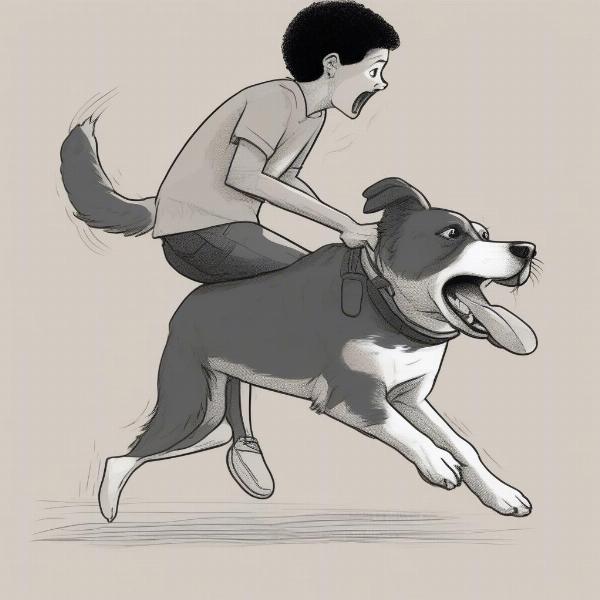Understanding why your dog jumps on you from behind can be puzzling. Is it affection, playfulness, or something else entirely? This behavior, while sometimes endearing, can be startling and even dangerous, especially with larger breeds. This article will delve into the various reasons behind this behavior, offering practical solutions to help you manage and redirect it.
Decoding Your Dog’s Back-End Jumps
Several factors can contribute to your dog’s habit of jumping on you from behind. Identifying the underlying cause is the first step towards addressing the behavior.
-
Excitement and Greeting: Often, a dog jumps as a way of expressing their excitement and joy at seeing you. This is particularly common when you return home after an absence. The jump is their way of saying hello and seeking attention.
-
Playfulness and Invitation to Play: A playful jump from behind can be an invitation to engage in a game. This might be accompanied by other playful behaviors, such as bowing, tail wagging, or bringing you a toy.
-
Attention-Seeking Behavior: If your dog feels ignored or wants your attention, they might resort to jumping as a way to get it. This can be particularly true if they’ve learned that jumping elicits a reaction from you, even if it’s negative.
-
Anxiety or Insecurity: In some cases, jumping can stem from anxiety or insecurity. Jumping on you from behind might provide a sense of security or control, especially if they’re feeling overwhelmed or stressed.
-
Herding Instinct: Some breeds, particularly those with herding instincts, might jump from behind as a residual herding behavior. They might be trying to “herd” you by nudging you with their body.
 Dog jumping on owner from behind
Dog jumping on owner from behind
Addressing the Jumping Behavior
Once you’ve identified the likely reasons behind your dog’s jumping, you can begin to address the behavior effectively.
-
Consistent Training: Consistency is key in dog training. Whenever your dog jumps on you from behind, gently but firmly say “no” or “off.” Turn away from them and avoid eye contact. Do not reward the jumping behavior with attention, even negative attention.
-
Positive Reinforcement: Reward your dog when they exhibit desired behaviors, such as sitting or staying calmly. Use positive reinforcement techniques like treats, praise, or petting when they greet you appropriately.
-
Redirect Their Energy: If your dog jumps out of excitement or playfulness, redirect their energy towards a more appropriate activity. Offer them a toy to play with or engage them in a short training session.
-
Manage Anxiety: If anxiety is a contributing factor, consider creating a calm and predictable environment for your dog. Provide them with a safe space, such as a crate or bed, where they can retreat when feeling overwhelmed.
Practical Tips for Curbing Jumping
Here are some additional practical tips to help you curb your dog’s jumping behavior:
-
Ignore the Jumping: Completely ignoring the jumping behavior can be effective, especially if your dog is seeking attention. Turn your back, avoid eye contact, and wait until they calm down before interacting with them.
-
Teach an Alternative Behavior: Teach your dog an alternative behavior, such as sitting, when they greet you. Reward them consistently for sitting when they see you, and eventually, they’ll learn that sitting is a more effective way to get your attention.
-
Seek Professional Help: If you’re struggling to manage your dog’s jumping behavior on your own, consider seeking help from a certified dog trainer or behaviorist. They can provide personalized guidance and develop a training plan tailored to your dog’s specific needs.
Conclusion
While a dog jumping on you from behind can be annoying or even frightening, with consistent training and patience, you can effectively manage and redirect this behavior. Understanding the underlying causes and implementing appropriate strategies will help you build a stronger, more positive relationship with your furry friend. Remember to be patient and consistent, and your dog will eventually learn to greet you in a more appropriate manner.
FAQ
-
Why does my dog jump on my back specifically? Jumping on your back might be a way for them to reach your face, especially for smaller dogs, or a manifestation of herding instincts.
-
Is it ever okay to let my dog jump on me? While personal preferences vary, allowing jumping can reinforce the behavior and make it harder to manage in the long run, especially around guests or children.
-
How long does it take to train a dog not to jump? The training timeframe varies depending on the dog’s age, breed, and consistency of training. It can take weeks or even months to see significant changes.
-
What if my dog continues to jump despite training? If your dog continues to jump despite your efforts, consult a certified dog trainer or behaviorist for professional help.
-
Can punishment stop my dog from jumping? Punishment is generally ineffective and can worsen the behavior or create fear and anxiety. Focus on positive reinforcement and redirection techniques instead.
-
Should I use a leash to prevent jumping? A leash can be a helpful tool for managing and controlling jumping, especially during training.
-
Can jumping be a sign of a medical issue? While unlikely, excessive or sudden changes in behavior can sometimes indicate underlying medical issues. Consult your veterinarian if you notice any other unusual symptoms.
ILM Dog is a leading international dog website dedicated to providing expert advice on dog care and training. We cover a range of topics, from breed selection and health care to nutrition and behavior. Whether you’re a new dog owner or a seasoned expert, ILM Dog offers valuable resources and practical tips to help you provide the best possible care for your canine companion. For personalized advice or to learn more about our services, contact us at [email protected] or +44 20-3965-8624. Visit us today at ILM Dog.